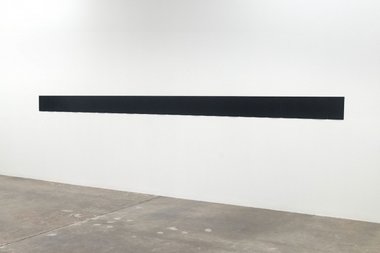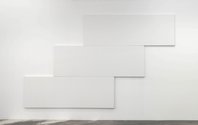John Hurrell – 1 August, 2013
Black and white, the two colours play off against each other: in our culture one standing for death, the other for life. Here the black CV sheets - though easily readable - look charred from a distance, as if burnt. The white painting (thin white laid over store-bought white-painted canvases) on the other hand is staggered - ascending from left to right - as if heading upwards to heaven. Hell/heaven, mind (a list of projects)/body (their manual application) cleverly divided.
Made in the last couple of years of Julian Dashper’s life, a period during which he was slowly succumbing to cancer, the three works here are collectively a sort of final contemplation on life and death - what they stand for - and how an artist’s career can straddle them both.
The ‘life’ element is in the Lett office with a drum skin hanging on the wall, no circular coloured bands, but with a hole in the centre that turns it into a sort of ‘zero’ - the fleshy hole we pop out of at the beginning and the earthy hole we drop into at the end. Untitled was made in 1993 and represents (via the active process of ‘drumming’) the cultural impact a human life might have, the contribution a single individual can present to the community they are part of.
The ‘death’ component is a tiered, three canvas configuration stacked flat on the wall like three steps. Its title alludes to McCahon‘s similarly titled painting - the large one (Part 2) Prime Minister Muldoon gave to the National Gallery of Australia - and could be vainglorious in motive or mischievous.
The third aspect is the ‘straddling’ combination of death mixed with life, found in Untitled (CV) 1994-2013, 1994. It consists of Dashper‘s CV, laser printed on black paper, A4 size. There are 27 sheets, numerically 3 x 3 x 3. Like Untitled (Victory Over Death Part 3), 2007, this item is presented in the main gallery, with the two works facing each other on opposite walls: Great North Road side versus gallery office side.
Black and white, the two colours play off against each other: in our culture one standing for death, the other for life. Here the more conspicuous black CV sheets - though easily readable - look charred from a distance, as if burnt. The white painting (thin white laid over store-bought white-painted canvases) on the other hand is staggered - ascending from left to right - as if heading upwards to heaven. Hell/heaven, mind (a list of projects)/body (their manual application) cleverly divided.
There are other interpretations too one can draw out from this pair of works. One is that the black line of paper sheets could be a horizon line, possibly referencing Mike Parr’s The Slot (Photography) 1987, a shallow box-like wooden wall sculpture that is 40 feet long and 6 inches high. Dashper’s shorter work was installed by Dane Mitchell during this exhibition’s opening, a process referencing its self-perpetuating nature. As an ever lengthening horizon-line it turns culture into nature, a constantly encircling circumference that starts to delineate an artist-centred solipsistic universe. The white ‘steps’ though provide an alternative, a ladder out into the world, a means through the support of the canvas surface of engaging with it and representing it. In the galley space, two polar opposites in perfect balance.
John Hurrell


 Advertising in this column
Advertising in this column Two Rooms presents a program of residencies and projects
Two Rooms presents a program of residencies and projects



This Discussion has 0 comments.
Comment
Participate
Register to Participate.
Sign in
Sign in to an existing account.